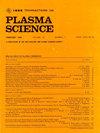真空断流器交流电压电极调节方法的评价
IF 1.5
4区 物理与天体物理
Q3 PHYSICS, FLUIDS & PLASMAS
引用次数: 0
摘要
本文介绍了一种有效的调节方法,通过施加交流电压,使额定84 kV的真空灭流器达到400 kV的耐雷击电压。作为第一步,我们通过再现在气体绝缘开关设备中安装灭弧器时的电场来测量电弧屏蔽的浮动电势。电势约为施加电压的40%。利用测量的电势,用轴对称二维有限元法计算了真空灭流器的电场。然后,对真空灭流器的外形尺寸进行了设计,使其满足绝缘设计要求。施加电压时的间歇性放电在1分钟内停止。在此条件下,我们成功地承受了400千伏以上的雷击电压。此外,我们还证实,即使对于带有焊接痕迹的接触电极,也可以通过这种调节达到400千伏。结果支持了该调理方法的有效性。因此,这种设计和调节工艺可以通过开关电弧和施加雷击电压来消除传统的调节工艺,从而达到400kv的雷击耐压。本文章由计算机程序翻译,如有差异,请以英文原文为准。
Evaluation of Electrode Conditioning Method of Applying AC Voltage for Vacuum Interrupters
This work describes an efficient conditioning method to achieve 400 kV of lightning impulse withstand voltage for the vacuum interrupter rated at 84 kV by applying ac voltage. As the first step, we measured the floating electric potential of the arc shield by reproducing the electric field when the interrupter was installed in gas-insulated switchgears. The electric potential was about 40% of the applied voltage. Using the measured potential, the electric field of the vacuum interrupter was calculated with axisymmetric 2-D finite element method. Then, the dimensions of the vacuum interrupter were designed so as to satisfy the insulation design criteria. The intermittent discharge during voltage application was stopped within 1 min. With this conditioning, we succeeded in withstanding lightning impulse voltage of 400 kV or more. Also, we confirmed that 400 kV could be achievable by this conditioning even for the contact electrode with welded traces. The results support the effectiveness of this conditioning method. As a result, this design and conditioning process enabled to eliminate conventional conditioning processes by switching arc and applying lightning impulse voltage in order to achieve 400 kV of lightning impulse withstand voltage.
求助全文
通过发布文献求助,成功后即可免费获取论文全文。
去求助
来源期刊

IEEE Transactions on Plasma Science
物理-物理:流体与等离子体
CiteScore
3.00
自引率
20.00%
发文量
538
审稿时长
3.8 months
期刊介绍:
The scope covers all aspects of the theory and application of plasma science. It includes the following areas: magnetohydrodynamics; thermionics and plasma diodes; basic plasma phenomena; gaseous electronics; microwave/plasma interaction; electron, ion, and plasma sources; space plasmas; intense electron and ion beams; laser-plasma interactions; plasma diagnostics; plasma chemistry and processing; solid-state plasmas; plasma heating; plasma for controlled fusion research; high energy density plasmas; industrial/commercial applications of plasma physics; plasma waves and instabilities; and high power microwave and submillimeter wave generation.
 求助内容:
求助内容: 应助结果提醒方式:
应助结果提醒方式:


